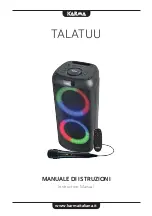
7
Be aware that flying sparks or falling slag can pass through cracks, along pipes, through windows
or doors, and through wall or floor openings, out of sight of the goggled operator. Sparks and slag
can fly 10m.
To prevent fires and explosion: keep equipment clean and operable, free of oil, grease, and (in
electrical parts) of metallic particles that can cause short circuits. If combustibles are in area, do
NOT weld or cut. Move the work if practicable, to an area free of combustibles.
Avoid paint spray rooms, dip tanks, storage areas, ventilators. If the work cannot be moved,
move combustibles at least 10m. away out of reach of sparks and heat; or protect against ignition
with suitable and snug fitting, fire- resistant covers or shields.
Walls touching combustibles on opposite sides should not be welded on (or cut).
Walls, ceilings, and floor near work should be protected by heat resistant covers or shields. Fire
watcher must be standing by with suitable fire extinguishing equipment during and for some time
after welding or cutting if:
a) appreciable combustibles (including building construction) are within 10m.
b) appreciable combustibles are further than 10m but can be ignited by sparks.
c) openings (concealed or visible) in floors or walls within 10m can expose combustible
materials to sparks.
d) combustibles adjacent to walls, ceilings, roofs or metal partitions can be ignited by
radiant or conducted heat.
After the work is done, check that the area is free of sparks, glowing embers and flames. An
empty container that held combustibles, or that can produce flammable or toxic vapours when
heated, must never be welded on or cut, unless the container has first been cleaned. This
includes a thorough steam or caustic cleaning (or a solvent or water washing, depending on the
combustible’s solubility), followed by purging and inerting with nitrogen or carbon dioxide, while
using personal protective equipment.
Water filling just below working level may substitute for inerting.
A container with unknown contents should be cleaned (see paragraph above), do NOT depend on
sense of smell or sight to determine if it is safe to weld or cut.
Hollow castings or containers must be vented before welding or cutting - they can explode.
In explosive atmospheres, never weld or cut where the air may contain flammable dust, gas, or
liquid vapours.
Содержание Arc/Tig135
Страница 1: ...OPERATING MAINTENANCE INSTRUCTIONS Model No Arc Tig135 PART NO 6010790 0612 ARC TIG WELDER...
Страница 24: ...24 PARTS DIAGRAM...
Страница 26: ...26 WIRING DIAGRAM...
Страница 28: ......








































